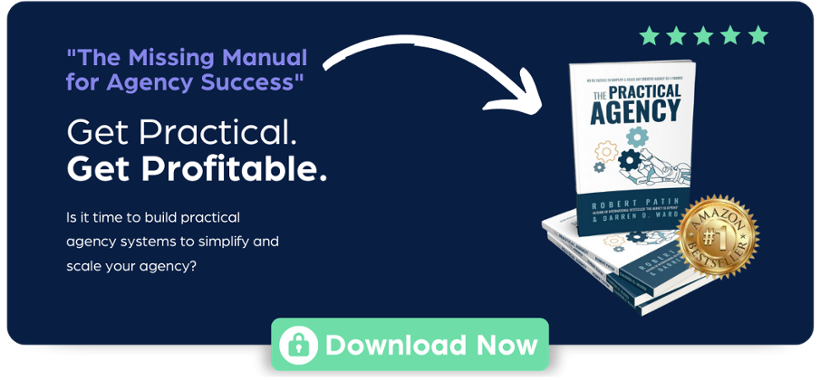Analyzing Your Agency’s Lead Generation Funnel for Maximum Conversion

How risk-proof is your creative agency?
How quickly you can generate new revenue is a key indicator of how well your agency can withstand the challenging moments that will inevitably occur. If your sales pipeline doesn’t currently have at least 10% of your 12 month goal monthly revenue at any given time, your agency will be financially vulnerable until your lead generation strategy gets some attention.
If this sounds familiar to your agency’s current situation- don’t get too discouraged. This is a common growing pain many agency owners face, especially during their first five years in business.
In the early days of your creative agency, you gained momentum as your initial network provided your first few clients, and success felt tangible. But as time passed, the reality of sustaining and growing your agency began to set in. The once steady stream of clients has become unpredictable, and now you’re entering sales calls with feelings of desperation.
This lack of confidence leads to underquoting or worse - coming across as desperate, turning potential clients away. It's a frustrating cycle that damages your bottom line and leaves you questioning the sustainability of your business.
Need to build your pipeline up to that $50K benchmark? Let's dive into how you can transform your agency from a state of unpredictability to a beacon of sustained success.
What Is A Lead Generation Funnel?
Not only do you need enough clients to pitch to, but they need to come at the right time as well. So to avoid overextending your team, yet keep the revenue flowing consistently, you’ll need to put a lead generation strategy in place.
Think of a lead generation funnel for a creative agency like a two-part roadmap guiding your sales process.
Demand Generation vs Lead Generation
If you’ve ever gotten frustrated when social media likes never seem to translate into booked sales calls, or outreach messages remain ignored - it’s time to reevaluate your sales strategy.
Unless you want to waste your valuable time endlessly cold calling or sifting through unqualified agency leads, it’s crucial to understand the distinction between lead generation and demand generation, as both play vital roles in your agency's success and require a delicate balance.
Clients can’t sign with you unless they know you exist. Implementing a demand generation strategy is critical in cultivating a broader awareness of your brand and desire for your services, setting the stage for lead generation.
Lead generation focuses on turning interest into action by showing prospective clients how to buy your specific services. A structured lead generation funnel can help your agency transform its approach to sales, moving from a haphazard, hit-or-miss method to a strategic, results-driven process.
Understanding the Stages of a Lead Generation Funnel
Remember, the purpose of a funnel is to filter larger amounts of input and distribute at a more manageable pace. A well-strategized sales funnel ensures that you don’t overextend your team’s operational bandwidth while maximizing your sales opportunities.
The biggest mistake a creative agency owner can make is assuming a prospect isn’t interested if they don’t sign after their first interaction with you. The reality is, only a small fraction of prospective clients you meet will be ready to invest in your services immediately - the rest need a little more time.
Recognizing (and accepting) these stages and understanding the difference in needs of prospects at each phase will significantly enhance the effectiveness of your sales and marketing efforts.
There are 5 stages of a creative agency lead generation funnel:
-
1. Initial Awareness
- Prospects are becoming aware of your agency as a potential solution to their needs. Maybe they stumble upon your website, see a social media post, or hear about you through word of mouth.
- Prospects may be just beginning to recognize their problem or need. They might be casually browsing, not yet deeply engaged or ready to commit.
- Focus on creating awareness through content marketing, social media presence, SEO, and brand visibility campaigns.
-
2. Generating Interest
- Once aware, prospects who start to show interest in your services are seeking more information as they consider if you could be the right fit for their needs.
- Here, prospects are actively looking for solutions and are more receptive to learning about your agency. They might sign up for your newsletter or follow your social media channels.
- Provide informative and engaging content like blog posts, how-to guides, and webinars to educate them and establish your agency as an authority.
-
3. Evaluation
- Prospects will start comparing your services against their needs and other options in the market and weighing the pros and cons of working with you.
- As they weigh their options, they might reach out with specific questions or requests for more detailed information.
- Share case studies, testimonials, and detailed service descriptions to ensure prompt and helpful responses to any inquiries.
-
4. Consideration
- Prospects at this stage are seriously considering hiring your agency. They have likely narrowed down their options and are close to making a decision.
- They might request a sales call or proposal, or a quote to discuss specific projects.
- Personalize your communication, offer tailored proposals, and be ready to discuss specific project details and pricing.
-
5. Final Decision
- The final stage where prospects decide whether or not to hire your services. It's crucial to make the final push and address any last-minute concerns.
- They are ready to make a decision but might need a final nudge or reassurance.
- Reinforce the value proposition of your agency, provide excellent customer service, and be clear about the next steps in the process.
As you can see, the mindset and behavior of your prospect change dramatically as they move down the funnel, so remember - even the best sales pitch will fail if not delivered at the right time.
Using CTA’s to Drive Traffic Down Your Funnel
So how do you capture your prospect’s attention to move them from the beginning to end or your funnel? Calls to Action (CTAs) are the crucial touchpoints that give them the push they need.
Their job is to provide direct instruction to your audience, compelling them to take a specific action that leads them further down your sales funnel. Whether it's signing up for a newsletter, downloading a guide, or scheduling a consultation, a good CTA can open the floodgates of further engagement with potential clients.
Integrating CTAs Effectively
An effective CTA should feel like a seamless progression for the reader, leading them from the information they're consuming to the next step you want them to take. It should offer something that resonates with your audience's current needs or interests.
CTA Ideas for Creative Agency Owners

Need some inspiration? Here are some practical, actionable examples of CTAs that you can use to attract and engage leads for your creative agency:
- Free Portfolio Review: “Unsure about your brand’s visual direction? Click here for a free portfolio review and let's explore how we can enhance your brand's image.”
- Downloadable Guides: “Grab our exclusive guide on ‘Top Design Trends for 2024’ and stay ahead in the creative game. Download now!”
- Webinar Sign-Ups: “Join our upcoming webinar on ‘Innovative Marketing Strategies for Digital Brands’ and discover the latest tactics to elevate your marketing. Reserve your spot today!”
- Consultation Offers: “Ready to take your branding to the next level? Schedule a free consultation with our creative experts and let's craft a unique strategy for your brand.”
- Newsletter Subscriptions: “Get the latest insights on creative branding and design right in your inbox. Subscribe to our newsletter for exclusive tips and updates.”
- Interactive Quizzes: “Not sure which branding style suits your business? Take our quick quiz to find out and get personalized recommendations!”
- Case Study Downloads: “See how we transformed Brand X’s visual identity and increased their engagement. Download the case study now to see the framework we followed.”
The goal of any CTA is to offer value to the potential client while guiding them towards deeper engagement with your agency. By providing resources, insights, and opportunities for direct interaction, these CTAs not only enhance your lead-generation efforts but also establish your agency as a knowledgeable and helpful authority in the creative industry.
Engaging Agency Leads with Email Marketing
Email marketing remains a powerful tool for engaging leads at all stages of your lead generation funnel.
As a creative agency, taking the time to segment and automate your email workflows can significantly enhance your lead nurturing process, and ensure you communicate the right message at the right time to the right audience.
Here are our top 5 tips to segment and automate your workflows:
-
1. Segment based on lead source and stage
-
- Segment your email list according to where leads originally came from (e.g., LinkedIn, website, podcast guest, guest posts, networking event, etc.) for more personalized communication, as each segment might have different needs and interests based on their lead source.
- Further segmentation can be done based on their stage in the funnel. For instance, leads in the awareness stage might need more general information about your services, whereas those in the consideration stage might benefit from detailed case studies or service comparisons.
- Segment your email list according to where leads originally came from (e.g., LinkedIn, website, podcast guest, guest posts, networking event, etc.) for more personalized communication, as each segment might have different needs and interests based on their lead source.
-
2. Creating Automated Email Workflows
-
- Automated email workflows ensure timely and consistent communication with your leads. You can set up different email sequences triggered by specific actions or behaviors, like downloading a digital lead magnet or signing up for a webinar.
- For example, send a welcome email followed by a series of educational emails to new subscribers to your email list. More complex workflows might involve multiple branches based on how leads interact with your initial emails.
-
3. Content Tailored to Each Stage
-
- The content of your emails needs to reflect the stage of the funnel each lead is in. For leads in the early stages, focus on providing value through educational content, industry insights, or creative inspiration.
- As leads move down the funnel, your emails can become more specific about your agency’s offerings, success stories, and unique selling points. This gradual shift helps in guiding leads from initial interest to serious consideration.
-
4. Personalization for Higher Engagement
-
- Use data from lead interactions on your website or previous emails to personalize content. For example, if a lead frequently reads blog posts about branding, your emails to them could focus more on branding services and case studies.
-
5. Testing and Optimization
-
- Regularly test different elements of your email campaigns, such as subject lines, email copy, or call-to-actions, to see what resonates best with your audience.
- Analyze the performance data of your email campaigns like open rates, click-through rates, and conversion rates. This data will help you continuously refine and improve your email marketing strategy.
Engaging leads effectively through email marketing is a blend of art and science. By understanding the needs and behaviors of your leads at different funnel stages and implementing well-segmented, automated email workflows, you can significantly improve the chances of converting these leads into clients.
Remember, the goal of email marketing in the context of a lead generation funnel is to build a relationship and establish trust, guiding your prospects through their journey from awareness to decision.
5 Tips for Optimizing Your Lead Generation Funnel
As a creative agency, fine-tuning your funnel is not just about generating more leads; it's about enhancing the quality and conversion rate of who you’re investing time into.
Taking the time to optimize your funnel can result in attracting more suitable clients and increasing your agency’s overall efficiency and profitability.
Here are 5 practical tips to make your lead generation funnel more effective:
1. Qualify Leads Early
-
- Define what makes a lead ideal for your agency. Consider factors like budget, project size, industry, and decision-making process.
- Implement a lead scoring system to assess the potential value of each lead. This helps in prioritizing leads that are more likely to convert, saving time and resources.
2. Find Tools That Fit Your Workflow
-
- Use automation tools that automate repetitive tasks in your funnel. For example, CRM software can automate lead nurturing emails or social media scheduling tools can manage your online presence.
- Utilize reporting tools that provide insights into your funnel’s performance. Understanding metrics like conversion rates at each stage can help identify bottlenecks and areas for improvement.
3. Use Trial and Error
-
- Don’t be afraid to try new tactics. Test different types of content, lead magnets, or marketing channels to see what works best for your target audience.
- Regularly conduct A/B tests on various elements like landing pages, email campaigns, and CTAs. This can provide valuable data on what resonates with your leads.
4. Learn from Rejected Leads
-
- If possible, collect feedback as to why leads didn’t convert. This feedback can be invaluable in refining your approach.
- Regularly review the reasons for lost leads and adjust your funnel strategy accordingly. Sometimes small tweaks can lead to significant improvements in conversion rates.
5. Keep Quick Turnaround Times on Leads
-
- Ensure your team responds quickly (ideally within 1 business day) to new leads. A prompt response can significantly increase the chances of conversion.
- Have templates and processes in place for common inquiries to streamline processes. This helps maintain consistency and efficiency in communication.
Lead Generation Is A Marathon - Not A Sprint
Optimizing your creative agency’s lead generation funnel is a continuous journey, crucial for your agency's growth. By qualifying leads early, using the right tools, learning from each interaction, and responding swiftly, you create an efficient and effective funnel.
Remember, fine-tuning your funnel is a step toward building a thriving agency. It's about creating a sustainable path for growth, and aligning your strategies with your target market's needs. Embrace this journey for a scalable, successful future.









